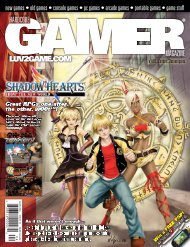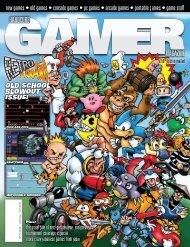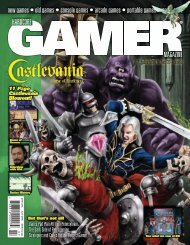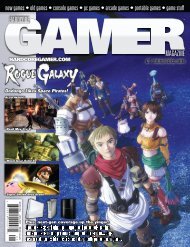Volume 2 Issue 6 December 2006 Sony ... - Hardcore Gamer
Volume 2 Issue 6 December 2006 Sony ... - Hardcore Gamer
Volume 2 Issue 6 December 2006 Sony ... - Hardcore Gamer
Create successful ePaper yourself
Turn your PDF publications into a flip-book with our unique Google optimized e-Paper software.
7 GAMES OF STYLE VS. SUBSTANCE<br />
REVIEWED BY: HONESTGAMER AND JAMES<br />
INTRODUCTION<br />
Simple is good. The over-complication of gaming has been a<br />
concern of Nintendo’s for a while now, and with bit Generations<br />
it’s taken game design back to its streamlined roots. bit<br />
Generations is a series of seven games designed to be as low-tech<br />
as possible, while showing off just how engaging simple gameplay<br />
can be. Plain but colorful visuals are combined with rich sound and<br />
stripped-down controls (Orbital only uses two buttons!) to create<br />
games that feel like they could have been pulled through time from<br />
the early ‘80s. That’s an illusion, though, because there’s more going<br />
on under the surface than is readily apparent. Ignoring the audio, which<br />
would have given even the mighty Commodore 64 some difculty, the sheer<br />
number of smooth-moving sprites wouldn’t have been possible until the<br />
latter days of the SNES. The bit Generations games are retro as seen through<br />
rose-colored glasses. Like many experiments, bit Generations is hit and miss.<br />
Game quality ranges from abysmal to brilliant, with most titles somewhere<br />
in the middle, but experiments in any media are what keep it alive and vital,<br />
whether it’s coming up with an entirely new play mechanic or just designing<br />
a game with an unusual visual sensibility. The results of the bit Generations<br />
project are seven abstract games with no media tie-ins, merchandisable<br />
characters, or stories to tell. The only thing to hook the player is gameplay.<br />
bit Generations shows that, though the early days of gaming were dened by<br />
hardware limitations, the style of gameplay from that period is timeless.<br />
N I N T E N D O ’ S B I T G E N E R A T I O N S I S T H E C L A S S I C C O L L I S I O N O F<br />
STYLE vs. SUBSTANCE<br />
PUBLISHER: NINTENDO . DEVELOPER: NINTENDO . RELEASE DATE: 07/13/06 . GENRE: ARCADE . CATEGORY: RETRO . # PLAYERS: 1<br />
Boundish sounds neat, but then you get past the name and you<br />
realize that what you’re really getting is four ways to play Pong, plus<br />
a variant of the sandbag game from California Games thrown in for<br />
good measure. It’s amusing for maybe three minutes, but it never<br />
reaches a point where you’ll feel like the nostalgia trip was justied.<br />
From the main menu, you’ll choose your poison. Each variant has a different little title, like “Pool Flower” or “Power Slider.” With the exception of<br />
“Box Juggling,” the aptly-named game that has you pushing a block into the air to score combo points until you’re bored out of your skull, each of<br />
the other options will nd you and the computer bouncing balls back and forth. They bound about the screen and apparently account for the game’s<br />
deceptively cool title.<br />
To mix things up between modes, the developers added slight variations and extremely irritating music loops. In one game mode, there’s a record at<br />
the center. You send the ball to your opponent and the constant spinning makes its path unpredictable. This is cool until your paddle suddenly won’t<br />
move properly. Another mode adds bubbles that drift through the area and slow your paddle’s movement, or your opponent’s. It’s like Pong, only<br />
more frustrating. A nal mode gives you two paddles connected by strings, so if your rst one misses,<br />
the backup might save you from an untimely defeat.<br />
The winning team in any but the “Box Juggling” mode is the one that reaches ve points. If you ask me,<br />
the real winner is the person who doesn’t play Boundish.<br />
1of 5<br />
PUBLISHER: NINTENDO . DEVELOPER: NINTENDO . RELEASE DATE: 07/13/<strong>2006</strong> . GENRE: RACING . CATEGORY: RETRO . # PLAYERS: 1<br />
PUBLISHER: NINTENDO . DEVELOPER: NINTENDO . RELEASE DATE: 07/13/<strong>2006</strong> . GENRE: PUZZLE . CATEGORY: RETRO . # PLAYERS: 1-2<br />
With six lines, a few shapes and some MIDI les, dotstream<br />
accomplishes what few games within the genre can: it makes<br />
handheld racing simple and thrilling. Even if the English menus<br />
hadn’t been included, North American gamers wouldn’t have trouble understanding what’s happening here. Good racing is universal.<br />
You are one of six lines moving from left to right. There’s a nite amount of space at any point, even in the early rounds. No two lines can occupy<br />
the same area, so as you and your rivals zip through the course, you’ll have to be careful. If you’re trailing someone and they avoid an obstacle<br />
perfectly, you’ll have to be either above them or below them on the vertical axis. Since your line adjusts automatically (and not always in the<br />
direction you’d prefer), you’ll sometimes nd yourself wiping out just because you didn’t plan in advance.<br />
That play mechanic provides the game’s tension. You must decide whether you should use all of your fuel boosts to snag and maintain the early<br />
lead, or if you should instead wait for a nal lap rush. Racing alongside your opponents increases the odds that you’ll totally wipe out and lose.<br />
Once you’ve broken free of the pack, it’s much simpler to plot the direct course you want to follow, but the game compensates for this by throwing<br />
obstacles at you that your opponents might have removed if you let them lead the charge.<br />
dotstream lives up to every inch of its promise with nary a polygon in sight. It won’t bring about a new<br />
revolution, but is still the sort of pleasant surprise that you won’t regret trying.<br />
4of 5<br />
Dialhex is another in a long line of puzzle games about arranging<br />
items by color, but instead of the usual three-in-a-row or column,<br />
it requires six triangles to be set in a hexagon. The cursor itself is<br />
a hexagon, and the shoulder buttons turn it left and right. You can<br />
move the small cursor around the large playeld hexagon, which<br />
contains ninety-six triangles. Pieces slowly rain down one at a time.<br />
As the pieces drop, they slowly accumulate at the bottom of the eld, piling up like pointy, colorful snow. The main mode starts off with only two<br />
colors to worry about, but clearing six hexagons of each color brings a new shade into the mix. Clear off six hexes of that color and get another one,<br />
and then more after that. Meanwhile, the slow rain of triangles is speeding up, the board is getting fuller, and the greater number of colors makes<br />
putting hexes together even trickier. Simple strategies and an organized plan of attack, plus taking full advantage of Dialhex’s few powerups, are the<br />
only ways to survive the later difculty levels.<br />
Dialhex is a surprisingly engaging little game, the kind that grows on you the more you play. Learning its patterns is tricky, but the puzzle game<br />
allure shines through once you get the hang of it. Unfortunately, setting up six of a color means that<br />
combos are rare, and predicting the way the triangles slide around once a hexagon disappears makes<br />
them almost impossible to set up. This keeps strategies simple but also limits the game’s depth. Despite<br />
this, Dialhex is still a fun little timewaster and makes a nice change from the usual puzzle fare.<br />
3.5of 5<br />
72_JAPAN_BIT GENERATIONS<br />
HARDCORE GAMER MAGAZINE_VOLUME 2_ISSUE 6_ELECTRIC PEEN<br />
HARDCORE GAMER MAGAZINE_VOLUME 2_ISSUE 6_ELECTRIC PEEN<br />
BIT GENERATIONS_JAPAN_73
















